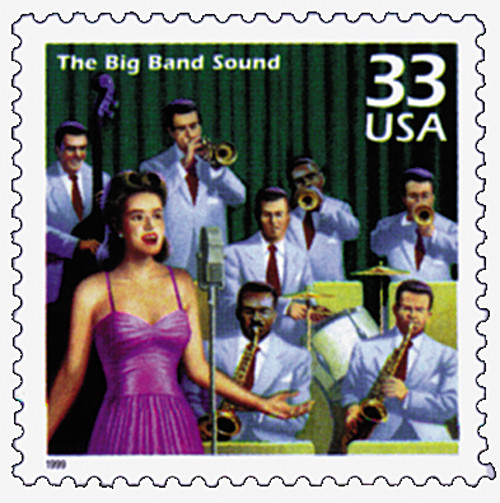
# 3186b - 1999 33c Celebrate the Century - 1940s: Antibiotics Save Lives
US #3186b
1999 Antibiotics Save Lives – Celebrate the Century (1940s)
• Part of the fifth sheet in the Celebrate the Century stamp series issued from 1998-2000
• Honors the refinement of antibiotic production and beginning of their widespread use
• Includes text on the back with historical details
Stamp Category: Commemorative
Series: Celebrate the Century
Value: 32¢ First Class Mail Rate
First Day of Issue: February 18, 1999
First Day City: Dobbins Air Force Base, Georgia
Quantity Issued: 188,000,000
Printed by: Ashton Potter (USA) Ltd.
Printing Method: Offset, Intaglio
Format: Panes of 15
Perforations: 11.5
Tagging: Block Tagging
Why the stamp was issued: To commemorate the introduction of antibiotics the world and celebrate the countless lives that have been saved because of them.
About the stamp design: Pictures a micrograph of penicillin mold by David Scharf. Includes the following text on the back: “Antibiotics are used to treat bacterial infections. Penicillin, derived from mold as shown on reverse, saved the lives of thousands of wounded soldiers during World War II. Postwar streptomycin has been highly effective in combating tuberculosis.”
First Day City: The First Day of Issue Ceremony was held at the Dobbins Air Force Base Fuel Cell Hangar in Georgia.
About the Celebrate the Century series: The USPS launched the Celebrate the Century series in 1998 to mark the end of the 20th century and herald the arrival of the 21st. The series includes 10 sheets of 15 stamps (150 in total), with each honoring important moments from a different decade (1900s, 10s, 20s, 30s, 40s, 50s, 60s, 70s, 80s, and 90s). At the time of completion, it was the longest and most ambitious commemorative stamp series in US history.
History the stamp represents: The antibiotic era began in 1928, when Sir Alexander Fleming discovered penicillin at St. Mary’s Hospital in England. Initial attempts to treat human infections with the antibiotic were unsuccessful because the substance was unstable and not very strong. After further experimentation at Oxford University, the drug was used with dramatic results in treating serious infections.
The start of World War II interfered with the large-scale manufacture of penicillin in England. As a result, methods for its mass production, purification, and stabilization were moved to the United States.
Extensive research on other antibiotics was still taking place in England. At St. Mary’s, Fleming and his team were producing tetanus toxoid for immunizing the troops. In addition, the lab was also producing vaccines against typhoid, cholera, diphtheria, whooping cough, and influenza.
In the 1930s, as many as 85 percent of people infected with pneumonia died. By the 1960s, that number had dropped to five percent. As a result of the development of various antibiotics in the 1940s, the chance of survival has drastically increased for those who suffer from spinal meningitis, typhoid fever, rheumatic fever, and various other diseases.
US #3186b
1999 Antibiotics Save Lives – Celebrate the Century (1940s)
• Part of the fifth sheet in the Celebrate the Century stamp series issued from 1998-2000
• Honors the refinement of antibiotic production and beginning of their widespread use
• Includes text on the back with historical details
Stamp Category: Commemorative
Series: Celebrate the Century
Value: 32¢ First Class Mail Rate
First Day of Issue: February 18, 1999
First Day City: Dobbins Air Force Base, Georgia
Quantity Issued: 188,000,000
Printed by: Ashton Potter (USA) Ltd.
Printing Method: Offset, Intaglio
Format: Panes of 15
Perforations: 11.5
Tagging: Block Tagging
Why the stamp was issued: To commemorate the introduction of antibiotics the world and celebrate the countless lives that have been saved because of them.
About the stamp design: Pictures a micrograph of penicillin mold by David Scharf. Includes the following text on the back: “Antibiotics are used to treat bacterial infections. Penicillin, derived from mold as shown on reverse, saved the lives of thousands of wounded soldiers during World War II. Postwar streptomycin has been highly effective in combating tuberculosis.”
First Day City: The First Day of Issue Ceremony was held at the Dobbins Air Force Base Fuel Cell Hangar in Georgia.
About the Celebrate the Century series: The USPS launched the Celebrate the Century series in 1998 to mark the end of the 20th century and herald the arrival of the 21st. The series includes 10 sheets of 15 stamps (150 in total), with each honoring important moments from a different decade (1900s, 10s, 20s, 30s, 40s, 50s, 60s, 70s, 80s, and 90s). At the time of completion, it was the longest and most ambitious commemorative stamp series in US history.
History the stamp represents: The antibiotic era began in 1928, when Sir Alexander Fleming discovered penicillin at St. Mary’s Hospital in England. Initial attempts to treat human infections with the antibiotic were unsuccessful because the substance was unstable and not very strong. After further experimentation at Oxford University, the drug was used with dramatic results in treating serious infections.
The start of World War II interfered with the large-scale manufacture of penicillin in England. As a result, methods for its mass production, purification, and stabilization were moved to the United States.
Extensive research on other antibiotics was still taking place in England. At St. Mary’s, Fleming and his team were producing tetanus toxoid for immunizing the troops. In addition, the lab was also producing vaccines against typhoid, cholera, diphtheria, whooping cough, and influenza.
In the 1930s, as many as 85 percent of people infected with pneumonia died. By the 1960s, that number had dropped to five percent. As a result of the development of various antibiotics in the 1940s, the chance of survival has drastically increased for those who suffer from spinal meningitis, typhoid fever, rheumatic fever, and various other diseases.














